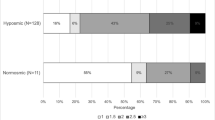Summary.
Olfactory loss is a prominent symptom in idiopathic Parkinson's disease (IPD). Experiment 1 re-investigated the diagnostic value of psychophysical testing in the differentiation between idiopathic Parkinson disease (IPD) from non-IPD; 50 consecutive PS patients participated. In Experiment 2 five de-novo patients received 3 olfactory tests spread over a period of appoximately one year. Nineteen IPD patients were anosmic, and 18 were hyposmic. All but one patient with MSA and PSP had mild/moderate hyposmia. Normosmia was found in CBD/misdiagnosed PS/psychogenic movement disorder. In Experiment 2, one of the de-novo patients was normosmic, 3 hyposmic, and 1 anosmic. Follow up investigations indicated decreased olfactory function in 3 patients while it improved in one. The normosmic patient retained olfactory abilities. This patient failed to respond to pharmacological treatment. In summary, olfactory tests differentiate IPD from non-IPD. Furthermore, tests of olfactory function may also be of interest in investigations related to treatment of PS.
Similar content being viewed by others
Author information
Authors and Affiliations
Additional information
Received December 10, 2001; accepted January 23, 2002
Rights and permissions
About this article
Cite this article
Müller, A., Reichmann, H., Livermore, A. et al. Olfactory function in idiopathic Parkinson's disease (IPD): results from cross-sectional studies in IPD patients and long-term follow-up of de-novo IPD patients. J Neural Transm 109, 805–811 (2002). https://doi.org/10.1007/s007020200067
Issue Date:
DOI: https://doi.org/10.1007/s007020200067




